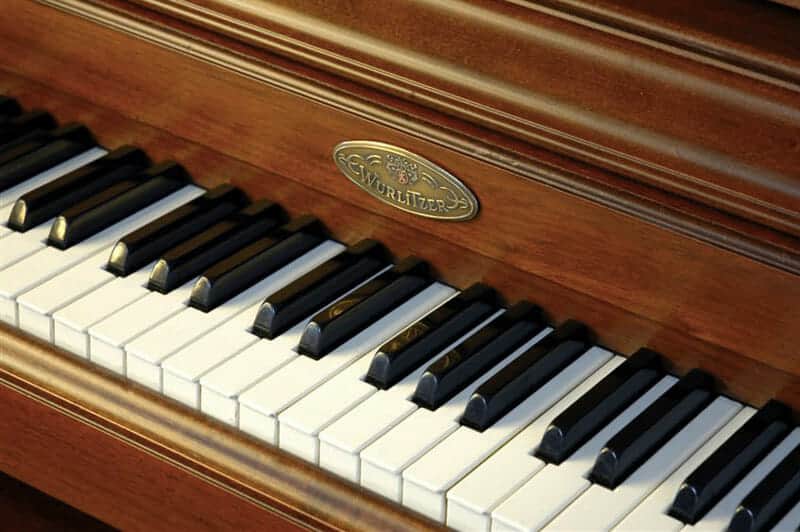

- #1963 wurlitzer spinet piano value serial#
- #1963 wurlitzer spinet piano value portable#
- #1963 wurlitzer spinet piano value series#
They did not yet stop producing the tube-amped 720A at this time, but they made parallel internal changes to these instruments going forward. In late 1964, Wurlitzer upgraded the solid-state 140A to the 140B, and the tube-amped 145A to the 145B. Some early-ish 720A’s have a potential problem of brittle, cracking reed screw washers that said, every example I’ve encountered has had either decent original screws or evidence of a recall-fix. If only 5 are cut short, it’s a 720A (or later, depending on other features). If the top 11 arms are cut short, as on a 700, it’s a “pre-A” 720. The only way to visually tell a 720 from a 720A is by removing the lid and looking at the treble damper arms.
#1963 wurlitzer spinet piano value series#
The crucial difference is in the reeds: As with the other 1960’s “A” series instruments (the 140A and 145A), it debuts the reeds that would be retained into the later 200 series. (Check for the badge under the left front of the keyboard.) Like the 720, it has a 145/720 tube amp.

#1963 wurlitzer spinet piano value serial#
The 720A, introduced in early or mid-1963 (at more or less the same time as the 140A and 145A), is externally indistinguishable from a 720 (at least visually) if you can’t find the serial badge. While there is seemingly less variation in varnish color than in a 700, there are still darker and lighter 720 series instruments, and perhaps even different woods used in some of the cases. Does this mean the sustain mechanism attaches differently/closer to the keys than in the portables? Subject for further study.
#1963 wurlitzer spinet piano value portable#
I have yet to compare the portable and console instruments side-by-side, but it’s my hunch that the two extra inches of key length necessitated moving the action further back in the cabinet.

The amp sits in the bottom of the console, as in a 700. Unlike a 140 or 145, the amp cannot fit behind the action - the cavity is smaller. The “on/off” light is just above the pedals, and the headphone jack is under the keyboard, on the baseboard. (On a very early instrument, each keystick had lead weights in the far ends, not just the low “A” and high “C”.) Like the “pre-A” 145, it retains the reeds of the 120 series from note #21 on up in all three “pre-A” models, the lowest 20 notes are a new design, similar in appearance to the 200 bass reeds, though apparently distinct, and only used in this small run of instruments. It has a 145 tube amp, the same stock of massive 4-ohm 12″ speaker as a 700 …and keysticks that are two inches longer than on a 145. It is a living room/furniture variation on a “pre-A” portable 145, and features the same complete makeover of the internal action of that model, and of the solid state portable 140 (compared to the 1950’s designs). The “pre-A” 720, introduced in mid-to-late 1962, is an almost completely different animal from the 700. The other most obvious external difference between the 700 and the later models, in the absence of an original music stand, will be the grille design: The exception will be the 726B/726 classroom model, which will have two monitor switches on the cheek block, instead of the vibrato knob. In comparison, most of the 720 series models will have TWO knobs, on the left cheek block, the second for the newly-introduced internal vibrato. What then?Īn easy way to distinguish a 700 from the later models is the single on-off/volume knob, located either on the left cheek block or above the bass keys. You suspect it is labeled poorly, and can’t examine it in person. The tube amp, unless it has been replaced, will be called some variation of a “120/700” amp, a “600” amp, or a “1200” amp, instead of a “145/720” tube amp or a 140B solid state amp.īut let’s say you are looking at an instrument for sale on the internet. The action is the 120 design, in its parallel subtle evolutions over their shared 5 or 6 year production run. The damper mechanism is attached to the sustain pedal by a long wooden leg, instead of using the cable technology standard to most other Wurlitzer models. Under the hood, the 700 is easy to tell from the later models. A distinctive feature of the 700, beyond its size and visual appeal, is the bass response, the result of its baseboard-mounted massive 12″ speaker, which resonates the whole body of the instrument. I’ve posted a complete essay on this already. The 700 (1957-1961) is the furniture version of the portable 120.

720A (1963-5, in two distinct consecutive variations).700 (1957-1961, with a few variations in color and music stands, and physical design/amp changes over time).Except for the 720B and classroom 726(B), there was no overlap between runs of these instruments: Wurlitzer made five models in this sub-spinet size furniture console series.


 0 kommentar(er)
0 kommentar(er)
